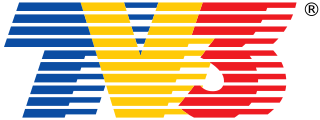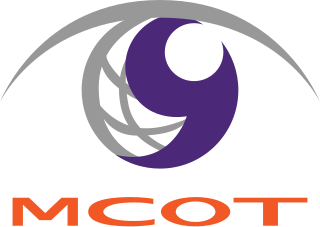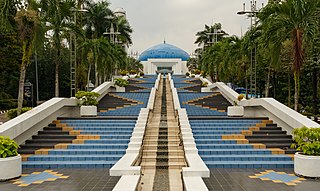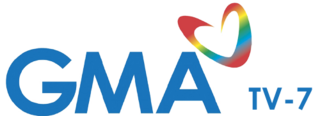
Terrestrial television or over-the-air television (OTA) is a type of television broadcasting in which the content is transmitted via radio waves from the terrestrial (Earth-based) transmitter of a TV station to a TV receiver having an antenna. The term terrestrial is more common in Europe and Latin America, while in Canada and the United States it is called over-the-air or simply broadcast. This type of TV broadcast is distinguished from newer technologies, such as satellite television, in which the signal is transmitted to the receiver from an overhead satellite; cable television, in which the signal is carried to the receiver through a cable; and Internet Protocol television, in which the signal is received over an Internet stream or on a network utilizing the Internet Protocol. Terrestrial television stations broadcast on television channels with frequencies between about 52 and 600 MHz in the VHF and UHF bands. Since radio waves in these bands travel by line of sight, reception is generally limited by the visual horizon to distances of 64–97 kilometres (40–60 mi), although under better conditions and with tropospheric ducting, signals can sometimes be received hundreds of kilometers distant.

The Kuala Lumpur Tower, colloquially referred to as KL Tower, is a 6-storey, 421-metre-tall telecommunication tower in Kuala Lumpur, Malaysia. It is the world's seventh-tallest tower. It features an antenna which increases its height to 421 metres. The roof of the pod is at 335 metres. The rest of the tower below has a stairwell and an elevator to reach the upper area, which also contains a revolving restaurant, providing diners with a panoramic view of the city.

Malaysian television broadcasting was introduced on 28 December 1963. Colour television was introduced on 28 December 1978. Full-time colour transmissions were officially inaugurated on New Year's Day 1982. There are currently 16 national free-to-air terrestrial television channels in Malaysia and 3 national pay subscription television operators in Malaysia.

Sistem Televisyen Malaysia Berhad, operating as TV3, is a Malaysian free-to-air television channel owned by Malaysian media conglomerate, Media Prima. TV3 is the third oldest TV station in Malaysia. It was launched on 1 June 1984 as the country's first and oldest private television channel. As of October 2021, TV3 remains to be the most-watched television station in Malaysia with about 17% of its viewing share among other Malaysian television stations, followed by TV9 with 15% of its viewing share, making two of them become the second most-watched television station in the country, despite the declining viewership of 3 free-to-air television channels.

The Wenvoe transmitting station, officially known as Arqiva Wenvoe, is the main facility for broadcasting and telecommunications for South Wales and the West Country. It is situated close to the village of Wenvoe in the Vale of Glamorgan, Wales, in the UK.

MCOT Public Company Limited, formerly known as the Mass Communication Organization of Thailand, is a Thai state-owned public broadcaster. It owns and operates a number of radio and television stations in Thailand. It is based in Bangkok.

THR is a defunct radio channel in Malaysia. It was the first private commercial radio station in the country, having based in the capital of Kuala Lumpur.

DWDB-TV is a television station in Metro Manila, Philippines, serving as the flagship of the GTV network. It is owned and operated by GMA Network, Inc. alongside GMA flagship DZBB-TV. Both stations share studios at the GMA Network Center, EDSA corner Timog Avenue, Diliman, Quezon City, while DWDB-TV's hybrid analog and digital transmitting facility is located at the GMA Tower of Power, Tandang Sora Avenue, Barangay Culiat, Quezon City.

This article lists important figures and events in Malaysian public affairs during the year 1994, together with births and deaths of notable Malaysians.
Freeview is New Zealand's free-to-air television platform. It is operated by a joint venture between the country's major free-to-air broadcasters – government-owned Television New Zealand and Radio New Zealand, government-subsidised Whakaata Māori, and the American-owned Warner Bros. Discovery.
PT Televisi Transformasi Indonesia, commonly known as Trans TV, is an Indonesian free-to-air television broadcaster based in South Jakarta that was launched on December 15, 2001, and is owned by Chairul Tanjung. Programming consists of newscasts, movies, drama series, variety shows, quiz shows, and children's television series. Trans TV was Indonesia's main broadcaster of the 2018 FIFA World Cup, showing most group matches and all of the final matches, which led to the channel topping Indonesian television ratings as of June 19, 2018.

DZBB-TV is a television station in Metro Manila, Philippines, serving as the flagship of the GMA network. It is owned and operated by the network's namesake corporate parent alongside GTV flagship DWDB-TV. Both stations share studios at the GMA Network Center, EDSA corner Timog Avenue, Diliman, Quezon City, while DZBB-TV's hybrid analog and digital transmitting facilities are located at the GMA Tower of Power, Tandang Sora Avenue, Barangay Culiat, Quezon City and Digital SFN relay towers located at PBCom Tower in Makati City, Zen Towers in Manila, Antipolo City, and Angeles City, Pampanga.

El 33 is Catalonia's second public television channel. It belongs to Televisió de Catalunya, a subsidiary of the CCMA.
DWKC-DTV is a television station in Metro Manila, Philippines, serving as the flagship of Broadcast Enterprises and Affiliated Media, Inc. Its main office is located at the 3rd floor, Globe Telecom Plaza 1, Pioneer St. cor. Madison St., Mandaluyong City, while its transmitter and master control is located at Palos Verdes Subdivision, Sumulong Highway, Brgy. Santa Cruz, Antipolo, Rizal.
Television frequency allocation has evolved since the start of television in Australia in 1956, and later in New Zealand in 1960. There was no coordination between the national spectrum management authorities in either country to establish the frequency allocations. The management of the spectrum in both countries is largely the product of their economical and political situation. New Zealand didn't start to develop television service until 1965 due to World War 2 and its economic harm in the country's economy.
Digital terrestrial television in the Philippines began in 2015 with the implementation of ISDB-T, currently coexisting with analog television that operates on the NTSC standard after the set analog switch-off (ASO) deadline encountered multiple postponements.
Television in Taiwan is primarily in Chinese and English. It is delivered through analog and digital, cable, IPTV, and the Internet.

Digital multimedia broadcasting (DMB) is a digital radio transmission technology developed in South Korea as part of the national IT project for sending multimedia such as TV, radio and datacasting to mobile devices such as mobile phones, laptops and GPS navigation systems. This technology, sometimes known as mobile TV, should not be confused with Digital Audio Broadcasting (DAB) which was developed as a research project for the European Union.

UHF television broadcasting is the use of ultra high frequency (UHF) radio for over-the-air transmission of television signals. UHF frequencies are used for both analog and digital television broadcasts. UHF channels are typically given higher channel numbers, like the US arrangement with VHF channels (initially) 1 to 13, and UHF channels (initially) numbered 14 to 83. Compared with an equivalent VHF television transmitter, to cover the same geographic area with a UHF transmitter requires a higher effective radiated power, implying a more powerful transmitter or a more complex antenna. However, the additional channels allow more broadcasters in a given region without causing objectionable mutual interference.

GMA Affordabox is a Philippine ISDB-Tb digital terrestrial television provider distributed and marketed by GMA New Media, a subsidiary of GMA Network. The service distributes digital set-top boxes and USB OTG dongles with free-to-air digital TV channels, broadcast markup language, emergency warning broadcast system, functional auto-on alert, digital display, and info display services to select areas in the Philippines.














